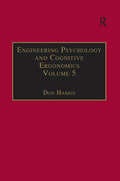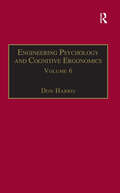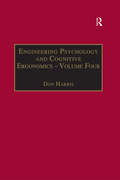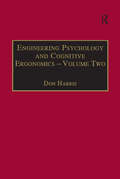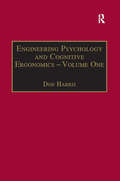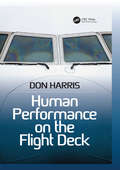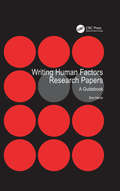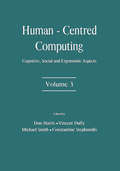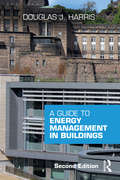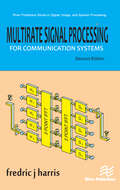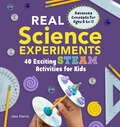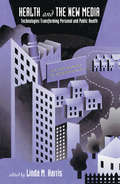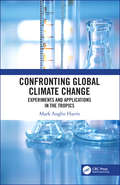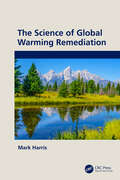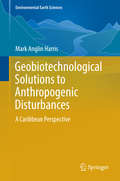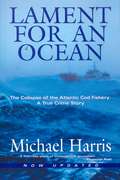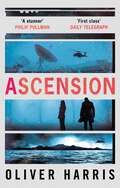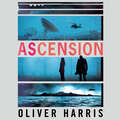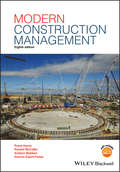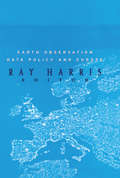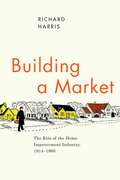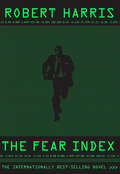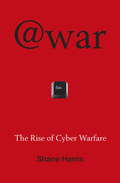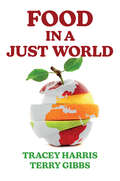- Table View
- List View
Engineering Psychology and Cognitive Ergonomics: Volume 5: Aerospace and Transportation Systems (Engineering Psychology And Cognitive Ergonomics Ser. #Vol. 4)
by Don HarrisThis is the fifth edited volume of refereed contributions, from an international group of researchers and specialists. Volumes Five and Six comprise the edited proceedings of the third international conference on Engineering Psychology Cognitive Ergonomics, organized by Cranfield College of Aeronautics, Edinburgh, Scotland in October 2000. Volume Five concentrates on applications in the areas of transportation, medical ergonomics and training. Topics addressed include: the design of control and display systems; human perception, error, reliability, information processing, and performance modelling; mental workload; stress; automation; situation awareness; skill acquisition and retention; techniques for evaluating human-machine systems and the physiological correlates of performance. Both volumes will be useful to applied and occupational psychologists, instructors, instructional developers, equipment and system designers, researchers, government regulatory personnel, human resource managers and selection specialists; also to senior pilots, air traffic control and aviation and ground transportation operations management.
Engineering Psychology and Cognitive Ergonomics: Volume 6: Industrial Ergonomics, HCI, and Applied Cognitive Psychology (Engineering Psychology And Cognitive Ergonomics Ser.)
by Don HarrisThis is the sixth edited volume of refereed contributions, from an international group of researchers and specialists. Volumes five and six comprise the edited proceedings of the Third International Conference on Engineering Psychology and Cognitive Ergonomics, organized by Cranfield College of Aeronautics, Edinburgh, Scotland, October 2000. The applications areas include aerospace and other transportation, medicine, human-computer interaction, process control, and training technology. Topics addressed include: the design of control and display systems; human perception, error, reliability, information processing, and performance modelling; mental workload; stress; automation; situation awareness; skill acquisition and retention; techniques for evaluating human-machine systems and the physiological correlates of performance. Both volumes will be useful to applied and occupational psychologists, instructors, instructional developers, equipment and systems designers, researchers, government regulatory personnel, human resource managers and selection specialists; also to senior pilots, air traffic control and aviation and ground transportation operations management.
Engineering Psychology and Cognitive Ergonomics: Volume 4: Job Design, Product Design and Human-computer Interaction
by Don HarrisThis book is the fourth in the series and describes some of the most recent advances and examines emerging problems in engineering psychology and cognitive ergonomics. It bridges the gap between the academic theoreticians, who are developing models of human performance, and practitioners in the industrial sector, responsible for the design, development and testing of new equipment and working practices.
Engineering Psychology and Cognitive Ergonomics: Volume 2: Job Design and Product Design (Engineering Psychology And Cognitive Ergonomics Ser. #Vol. 4)
by Don HarrisThis is the second of two edited volumes from an international group of researchers and specialists, which together comprise the edited proceedings of the First International Conference on Engineering Psychology and Cognitive Ergonomics, organized by Cranfield College of Aeronautics at Stratford-upon-Avon, England in October 1996. The applications areas include aerospace and other transportation, human-computer interaction, process control and training technology. Topics addressed include: the design of control and display systems; human perception, error, reliability, information processing, and human perception, error, reliability, information processing, and awareness, skill acquisition and retention; techniques for evaluating human-machine systems and the physiological correlates of performance. While Volume one is more clearly focused on the domain of aviation and ground transportation, Volume two is concerned with human factors in job and product design, the basics of decision making and training, with relevance to all industrial domains. Part one opens with a keynote chapter by Ken Eason. It is followed by Part two dealing with learning and training, while Part three reflects the rapidly growing area of medical ergonomics. Part four entitled 'Applied Cognitive Psychology' is biased towards human capabilities, an understanding of which is central to sound human engineering decisions. Part five firmly emphasizes equipment rather than its human operators.
Engineering Psychology and Cognitive Ergonomics: Volume 1: Transportation Systems (Engineering Psychology And Cognitive Ergonomics Ser. #Vol. 4)
by Don HarrisThis is the first of two edited volumes from an international group of researchers and specialists, which together comprise the edited proceedings of the First International Conference on Engineering Psychology and Cognitive Ergonomics, organized by Cranfield College of Aeronautics at Stratford-upon-Avon, England in October 1996. The applications areas include aerospace and other transportation, human-computer interaction, process control and training technology. Topics addressed include: the design of control and display systems; human perception, error, reliability, information processing, and human perception, error, reliability, information processing, and awareness, skill acquisition and retention; techniques for evaluating human-machine systems and the physiological correlates of performance. This volume covers Human Factors in transportation systems. Part One opens with a chapter by Chris Wickens on attentional issues in head-up displays; its concluding chapter by Peter Jorna, pulls together the Human Factors issues in air traffic management from both the pilot‘s and the air traffic controller‘s perspectives. Part Two considers the ground-based aspects to air traffic control, while Part Three emphasizes the psychology of the individual. The opening chapter of Part Four uses lessons learned from aviation to avoid similar mistakes in road vehicles. The final part contains topics such as naval command and control, and automation in trains and armoured fighting vehicles.
Human Performance on the Flight Deck
by Don HarrisTaking an integrated, systems approach to dealing exclusively with the human performance issues encountered on the flight deck of the modern airliner, this book describes the inter-relationships between the various application areas of human factors, recognising that the human contribution to the operation of an airliner does not fall into neat pigeonholes. The relationship between areas such as pilot selection, training, flight deck design and safety management is continually emphasised within the book. It also affirms the upside of human factors in aviation - the positive contribution that it can make to the industry - and avoids placing undue emphasis on when the human component fails. The book is divided into four main parts. Part one describes the underpinning science base, with chapters on human information processing, workload, situation awareness, decision making, error and individual differences. Part two of the book looks at the human in the system, containing chapters on pilot selection, simulation and training, stress, fatigue and alcohol, and environmental stressors. Part three takes a closer look at the machine (the aircraft), beginning with an examination of flight deck display design, followed by chapters on aircraft control, flight deck automation, and HCI on the flight deck. Part four completes the volume with a consideration of safety management issues, both on the flight deck and across the airline; the final chapter in this section looks at human factors for incident and accident investigation. The book is written for professionals within the aviation industry, both on the flight deck and elsewhere, for post-graduate students and for researchers working in the area.
Writing Human Factors Research Papers: A Guidebook
by Don HarrisWriting high-quality papers suitable for publication within international scientific journals is now an essential skill for all early-career researchers; their career progression and the reputation of the department in which they work depends upon it. However, many manuscripts are rejected or sent back for major re-working not because the science they contain is in any way 'bad', but because the same problems keep occurring in the way that the material is presented. It is one thing to write a good scientific paper, however it is quite another thing to get it published. This requires some additional nous. In writing this book Don Harris draws upon nearly a quarter of a century of experience as an author and reviewer of research papers, and ultimately as a journal editor. By his own admission, it contains all the things he wished that his mentors had told him 25 years ago, but didn't. The material in the book is drawn from many years of finding all these things out for himself, usually by trial and error (but mostly error!). The text adopts a much lighter touch than is normally found in books of this type - after all, who really wants to read a book about writing research papers? The author describes his own unique approach to writing journal papers (which, in his own words, has proved to be extremely successful). All major points are illustrated with examples from his own, published works. The book is written in the form of a manual for constructing a journal manuscript: read a chapter, write a section. However, the material it contains goes beyond just this and also describes how to select a target journal, the manuscript submission process, what referees are looking for in a good journal paper, and how to deal with the referees' comments. Each chapter concludes with a checklist to ensure all the key elements have been addressed.
Human-Centered Computing: Cognitive, Social, and Ergonomic Aspects, Volume 3
by Don Harris Vincent Duffy Michael Smith Constantine StephanidisThe 10th International Conference on Human-Computer Interaction, HCI International 2003, is held in Crete, Greece, 22-27 June 2003, jointly with the Symposium on Human Interface (Japan) 2003, the 5th International Conference on Engineering Psychology and Cognitive Ergonomics, and the 2nd International Conference on Universal Access in Human-Computer Interaction. A total of 2986 individuals from industry, academia, research institutes, and governmental agencies from 59 countries submitted their work for presentation, and only those submittals that were judged to be of high scientific quality were included in the program. These papers address the latest research and development efforts and highlight the human aspects of design and use of computing systems. The papers accepted for presentation thoroughly cover the entire field of humancomputer interaction, including the cognitive, social, ergonomic, and health aspects of work with computers. These papers also address major advances in knowledge and effective use of computers in a variety of diversified application areas, including offices, financial institutions, manufacturing, electronic publishing, construction, health care, disabled and elderly people, etc.
A Guide to Energy Management in Buildings
by Douglas HarrisThis new edition of A Guide to Energy Management in Buildings begins by asking why we need to control energy use in buildings and proceeds to discuss how the energy consumption of a building can be assessed or estimated through an energy audit. It then details a range of interventions to reduce energy use and outlines methods of assessing the cost-effectiveness of such measures. Topics covered include: where and how energy is used in buildings energy audits measuring and monitoring energy use techniques for reducing energy use in buildings legislative issues. And new in this edition: the cooling of buildings fuel costs and smart metering and education and professional recognition. It provides a template for instigating the energy-management process within an organization, as well as guidance on management issues such as employee motivation, and gives practical details on how to carry the process through. This book should appeal to building and facilities managers and also to students of energy management modules in FE and HE courses.
Multirate Signal Processing for Communication Systems (River Publishers Series In Signal, Image And Speech Processing Ser.)
by Fredric J. HarrisMultirate Signal processing can improve system performance and reduce costs in applications ranging from laboratory instruments, cable modems, wireless systems, satellites, Radar, Sonar, and consumer entertainment products. This second edition continues to offer a systematic, clear, and intuitive introduction to multirate signal processing for working engineers and system designers. Significant new material and fresh concepts, including Green Signal Processing techniques have been introduced. The author uses extensive examples and figures to illustrate a wide range of multirate techniques, from basic resampling to leading-edge cascade and multi-stage filter structures. Along the way he draws on extensive research and consulting experience to introduce processing “tricks” shown to maximize performance and efficiency. Coverage includes:• Effect of sampling and resampling in time and frequency domains• Relationships between FIR filter specifications and filter length (# of taps)• Window design and equal-ripple (Remez) design techniques• Square-Root Nyquist and Half-band Filters including new enhancements• Polyphase FIR filters: up-sampling, down-sampling• Polyphase M-path analysis and synthesis channelizers and cascade pairs• Polyphase interpolators for arbitrary sample rate changes• Dyadic half-band filters, quadrature mirror filters• Channel banks for multiple arbitrary bandwidths and center frequencies • Comprehensive coverage of recursive all-pass filters and channelizers, non-uniform and uniform phase, mixed recursive and non-recursive• Comparisons with traditional DSP designs• Extensive applications coverage throughout
Real Science Experiments: 40 Exciting STEAM Activities for Kids (Real Science)
by Jessica HarrisTake your scientific exploration to the next level with real experiments for kids ages 8 to 12 Here's a hypothesis you can prove: science is a ton of fun! These science experiments for kids give you the opportunity to test this theory using 40 exciting activities that teach you all about science, technology, engineering, art, and math—the full STEAM package! From microscopes and candle-powered boats to insect mind control and hydroponics, these science experiments for kids offer a hands-on approach to scientific discovery. Each of these engaging and repeatable experiments give you the chance to get up-close, personal, and creative with all kinds of amazing ideas that will show you how to be a real scientist. This collection of science experiments for kids includes: STEAM for you—Take STEAM learning into your own hands with awesome, easy-to-do science experiments for kids that are perfect for doing at home. Science made simple—From hypothesis to observation to results, learn all about the power of the scientific method—and how you can use it every day. Hows and whys—Each of these science experiments for kids details exactly why things happen the way they do, helping you better understand the results you see. Take your first step into a world of scientific discovery with the help of these amazing science experiments for kids.
Health and the New Media: Technologies Transforming Personal and Public Health (Routledge Communication Series)
by Linda M. HarrisThis book presents an evaluation framework for assessing the impact of the new media on the health care system by juxtaposing characteristics of emerging information and communication technologies (interactive, seamlessly connected, and user-driven) and health care objectives (to increase access, improve quality, and manage costs). Each chapter provides a unique set of tools and perspectives on how to harness these new media to improve individual health and the health care delivery system. This innovative volume has also stimulated the creation of a "Forum on Health and the New Media" on the World Wide Web (http://Health.Dartmouth.edu/NewMedia/). The forum offers highlights of the book as well as links to the authors and related web sites.The volume is divided into six sections as follows: *The "Overview" juxtaposes characteristics of the new media (interactive, connected, and user-driven) with the three criteria for health care improvement: increased access, improved quality, and cost management. It offers a New Media and Health Care matrix of criteria for building and evaluating emerging health care systems.*The "Delivery" -- how new media can enhance the delivery of health care -- includes chapters on: managed care, demand management and self-care, telemedicine for rural residents, and how the Internet can be used to facilitate collaboration among health researchers and providers.*Health Information -- the life blood of health care -- addresses the potential for: extending the traditional flow of health information (from researchers to providers) to reach patients who want to share in decisions about their care; and the federal government's role in providing health information to the public.*Health Education discusses: integrating multimedia health programming for public schools; using networked multimedia and simulation technologies and new learning theories that promise to transform public health education; and educating health providers and patients through interactive media and drama.*Potholes Along the Highway provides a sobering balance to otherwise rather optimistic assumptions that a national information infrastructure will be forthcoming. *The New Media: Annotated Glossary provides computing and networking technology tools for readers who are not fluent in cyberlanguage.
Confronting Global Climate Change: Experiments & Applications in the Tropics
by Mark HarrisThis book offers a solutions-based approach to climate change problems which potentially impinge on human beings within the tropics. It largely comprises research articles with supplementary applications and illustrations. <P><P>The effects of atmospheric phenomena, energy acquisition, wind power, CO2 sequestration, are linked with soils, aquatic life, reducing deforestation, rainwater harvesting and clay pot farming, climate, plant disease and food security to show that no area of life is untouched by the phenomenon of climate change. It discusses specific problem areas and provides an overview of geotechnical and sustainable solutions to lessen the impact of climate.
The Science of Global Warming Remediation
by Mark HarrisThe Science of Global Warming Remediation examines the workings of a complex chemical system using concepts such as chemical kinetics, thermodynamics, and oxidation/reduction. It focuses on preventing environmental deterioration as well as using environmental chemistry for environmental cleanup or remediation. Further, it describes how to utilize mechanical, chemical, and biological methods to detoxify contaminated land or water. The book also considers how environmental legislation aims to modify human behavior so as to reduce or eliminate the environmental threats identified through science. Features: Presents multiple methods for water treatment Explains the physiological dangers of exposure to various toxic materials Illustrates the mechanisms of major partitioning systems and sinks for carbon dioxide Examines the mechanics of global warming and the potential long-term effects Provides step-by-step solutions to empower individuals to act locally
Geobiotechnological Solutions to Anthropogenic Disturbances
by Mark Anglin HarrisThis book offers a problem-and-solution approach toenvironmental remediation in mining, including the environmentally sustainableutilization of waste materials from the mining industry. It largely comprisesarticles published in Springer journals, which have been thoroughly revised andexpanded. With supplementary data and illustrations, it discusses specificproblem areas in relevant Caribbean locations and provides an overview ofgeotechnical and microbial solutions to prevent post-mining deterioration inthis area.
Lament for an Ocean: The Collapse of the Atlantic Cod Fishery
by Michael HarrisThe northern cod have been almost wiped out. Once the most plentiful fish on the Grand Banks off the coast of Newfoundland, the cod is now on the brink of extinction, and tens of thousands of people in Atlantic Canada have been left without work by a 1992 moratorium on fishing the stock. Today, the Pacific salmon stocks are in similar trouble – victims of the same blind, stupid greed. Angry, accusatory fingers have been pointed at various possible culprits for the collapse of the cod – at the Spanish and Portuguese, who for hundreds of years sent ever-bigger fleets to the Grand Banks; at the factory-freezer trawlers, which “vacuumed” the ocean floor for the prized fish; at those inshore fishermen who circumvented the rules governing the fishery; at the federal Department of Fisheries and Oceans, which is responsible for managing the fishery; at the harp seal, the cod’s competitor for food, whose numbers have exploded in recent years; even at Nature, for lowering the temperature of the ocean. InLament for an Ocean,the award-winning true-crime writer Michael Harris investigates the real causes of the most wanton destruction of a natural resource in North American history since the buffalo were wiped off the face of the prairies. The story he carefully unfolds is the sorry tale of how, despite the repeated and urgent warnings of ocean scientists, the northern cod was ruthlessly exploited.
Ascension (An\elliot Kane Thriller Ser.)
by Oliver Harris'Oliver Harris's Ascension is a stunner. What a pleasure it is to read a book with a powerful story, an unusual and fully realised setting, a convincing hero, all written in a style of luminous clarity' Philip PullmanAscension: the most remote island in the world... Elliot Kane, former spy, trying to leave the world of espionage behind. Kathryn Taylor: a stalled career in MI6, running the South Atlantic desk. Rory Bannatyne: covert technical specialist. Dead, apparently of suicide. Three friends from a mission many years ago reconnect when one of them dies on Ascension Island. Rory Bannatyne had been tasked with tapping a new transatlantic data cable, but a day before he was due to return home he is found hanged. When Kathryn Taylor begs Kane to go over and investigate, he can't say no, but it's an uneasy reintroduction to the intelligence game. Ascension is a curious legacy of England's imperial past. Only employees and their families are allowed to live there. It's home to several highly-classified government projects, a British and American military base, and forty dead volcanic cones. Entirely isolated from the world, the disappearance of a young girl at the same time as Rory's death means local tensions are high. Elliot needs to discover what happened to her as well as to Rory. But the island contains more secrets than even the government knows, and it's not going to give them up without a fight.
Ascension
by Oliver Harris'Oliver Harris's Ascension is a stunner. What a pleasure it is to read a book with a powerful story, an unusual and fully realised setting, a convincing hero, all written in a style of luminous clarity' Philip PullmanAscension: the most remote island in the world... Elliot Kane, former spy, trying to leave the world of espionage behind. Kathryn Taylor: a stalled career in MI6, running the South Atlantic desk. Rory Bannatyne: covert technical specialist. Dead, apparently of suicide. Three friends from a mission many years ago reconnect when one of them dies on Ascension Island. Rory Bannatyne had been tasked with tapping a new transatlantic data cable, but a day before he was due to return home he is found hanged. When Kathryn Taylor begs Kane to go over and investigate, he can't say no, but it's an uneasy reintroduction to the intelligence game. Ascension is a curious legacy of England's imperial past. Only employees and their families are allowed to live there. It's home to several highly-classified government projects, a British and American military base, and forty dead volcanic cones. Entirely isolated from the world, the disappearance of a young girl at the same time as Rory's death means local tensions are high. Elliot needs to discover what happened to her as well as to Rory. But the island contains more secrets than even the government knows, and it's not going to give them up without a fight.
Ascension: an absolutely gripping BBC Two Between the Covers Book Club pick
by Oliver Harris'One of our finest thriller writers' Evening StandardA BBC2 BETWEEN THE COVERS BOOK CLUB PICK 2021'Oliver Harris is always pure quality' Ian Rankin'A fascinating tale of modern espionage in a unique setting' Irish IndependentThree friends from a mission many years ago reconnect when one of them dies in mysterious circumstances on remote Ascension Island. Rory Bannatyne had been tasked with tapping a new transatlantic data cable, but a day before he was due to return home he is found hanged. When Kathryn Taylor, on the South Atlantic MI5 desk, begs ex-spy Elliot Kane to go over and investigate, he can't say no, but it's an uneasy reintroduction to the intelligence game.Entirely isolated from the world, the disappearance of a young girl on the island at the same time as Rory's death means local tensions are high. Elliot needs to discover what happened to her as well as to Rory. But the island contains more secrets than even the government knows, and it's not going to give them up without a fight. WHAT READERS ARE SAYING'Captivating...Gripping, relevant and frenetic. You'll be hard pressed to put this one down for a second' Amazon reader five star review'Stunning spy novel...This is the best of its genre I've read' Amazon reader five star review'A bit like a thinking person's Lee Child' Amazon reader five star review
Modern Construction Management
by Prof. Frank Harris Prof. Ronald McCaffer Andrew Baldwin Francis Edum-FotweWhile the construction process still requires traditional skills, the dynamic nature of construction demands of its managers improved understanding of modern business, production and contractual practices. This well established, core undergraduate textbook reflects current best practice in the management of construction projects, with particular emphasis given to supply chains and networks, value and risk management, BIM, ICT, project arrangements, corporate social responsibility, training, health and welfare and environmental sustainability. The overall themes for the Eighth Edition Modern Construction Management are: Drivers for efficiency: lean construction underpinning production management and off-site production methods. Sustainability: reflecting the transition to a low carbon economy. Corporate Social Responsibility: embracing health & safety and employment issues. Modern contractual systems driving effective procurement Building Information Modelling directed towards the improvement of collaboration in construction management systems
Earth Observation Data Policy and Europe
by Ray HarrisEarth observation data policy has received little attention, even though the conditions of access to Earth observation data are fundamental to the exploitation of and the further growth of the Earth observation sector. This unique book addresses this limitation.
Building a Market: The Rise of the Home Improvement Industry, 1914-1960
by Richard HarrisEach year, North Americans spend as much money fixing up their homes as they do buying new ones. This obsession with improving our dwellings has given rise to a multibillion-dollar industry that includes countless books, consumer magazines, a cable television network, and thousands of home improvement stores. Building a Market charts the rise of the home improvement industry in the United States and Canada from the end of World War I into the late 1950s. Drawing on the insights of business, social, and urban historians, and making use of a wide range of documentary sources, Richard Harris shows how the middle-class preference for home ownership first emerged in the 1920s--and how manufacturers, retailers, and the federal government combined to establish the massive home improvement market and a pervasive culture of Do-It-Yourself. Deeply insightful, Building a Market is the carefully crafted history of the emergence and evolution of a home improvement revolution that changed not just American culture but the American landscape as well.
The Fear Index (Bride Series)
by Robert HarrisAt the nexus of high finance and sophisticated computer programming, a terrifying future may be unfolding even now. Dr. Alex Hoffmann's name is carefully guarded from the general public, but within the secretive inner circles of the ultrarich he is a legend. He has developed a revolutionary form of artificial intelligence that predicts movements in the financial markets with uncanny accuracy. His hedge fund, based in Geneva, makes billions. But one morning before dawn, a sinister intruder breaches the elaborate security of his lakeside mansion, and so begins a waking nightmare of paranoia and violence as Hoffmann attempts, with increasing desperation, to discover who is trying to destroy him. Fiendishly smart and suspenseful, The Fear Index gives us a searing glimpse into an all-too-recognizable world of greed and panic. It is a novel that forces us to confront the question of what it means to be human--and it is Robert Harris's most spellbinding and audacious novel to date.
@War
by Shane HarrisThe spies had come without warning. They plied their craft silently, stealing secrets from the world's most powerful military. They were at work months before anyone noticed their presence. And when American officials finally detected the thieves, they saw it was too late. The damage was done . . .It could have been the plot of a Tom Clancy thriller: Chinese hackers break into American defence contractors and steal the plans for a new multi-billion dollar fighter jet. In fact, it is just one dispatch from the frontline of a new form of warfare.Our wars are increasingly being fought online. GCHQ and the NSA gather vast amounts of information from the internet - and do so with the complicity of companies like Google and Facebook. The American military fields teams of hackers who can, and do, launch computer virus attacks against enemy targets. And with the majority of civil infrastructure - things like nuclear power stations, hospitals, airports and banking systems - now run across the internet, the next 9/11 could be a cyber-attack.Welcome to the modern world of warfare.
Food in a Just World: Compassionate Eating in a Time of Climate Change
by Tracey Harris Terry GibbsFood in a Just World examines the violence, social breakdown, and environmental consequences of our global system of food production, distribution, and consumption, where each step of the process is built on some form of exploitation. While highlighting the broken system’s continuities from European colonialism, the authors argue that the seeds of resilience, resistance, and inclusive cultural resurgence are already being reflected in the day-to-day actions of communities around the world. Calling for urgent change, the book looks at how genuine democracy would give individuals and communities meaningful control over the decisions that impact their lives when seeking to secure humanely this most basic human need. Drawing on the perspectives of advocates, activists, workers, researchers, and policymakers, Harris and Gibbs explore the politics of food in the context of capitalist globalization and the climate crisis, uncovering the complexities in our relationships with one another, with other animals, and with the natural world.
